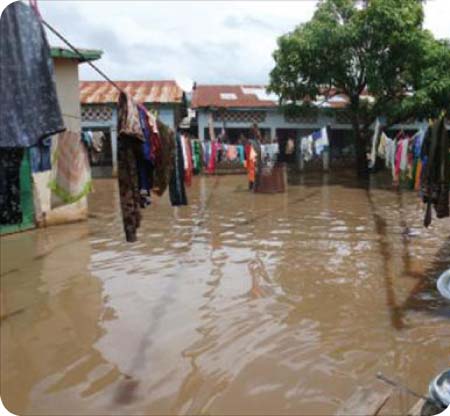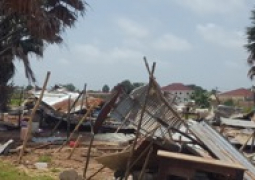
The flash floods affected 40,501 including 8,436 children under 59 months and 2,609 pregnant and lactating women.
As a result of the flooding, numerous incidents of diarrhoea and skin rashes have been reported in Tobacco-Road in Banjul over the past few days.
A total of 5,407 people have been internally displaced across the affected communities.
At least 52.4% of the IDPs are females who will need support on protection and related issues.
The NDMA and Red Cross have established a temporal IDP camp in Banjul which is housing about 350 people mostly women and children. The Camp is located at St Augustine`s Senior Secondary School.
“The majority of the IDPs are living with relatives. Hundreds of houses have been completely or partially damaged and unsafe for human habitation.”
“The July 30th and 31st Flash floods are the worst that have hit the Gambia in nearly half a
century. The torrential rain associated with thunderstorms resulted to flash flooding which
affected the entire country,” the Agency’s Situational report states.
According to the Department of Water Resources “rainfall quantity recorded during this period was 276 mm at Banjul International Airport, Yundum. The country experienced the same on 31st July 1998 with rainfall amount of 175.4 mm recorded.”
“The historical records of floods date as far back as 1948. Significant floods experienced in the country
were in 1988, 1999, and 2002, 2010, 2020 and now 2022. This shows that the frequency of flash
floods and climate related shocks are becoming more persistent.”
“Since the flash floods on July 31st, there have been almost daily heavy downpours in many parts of the country thereby exacerbating the floods in many communities.”
Affected Population
Sequel to the affected areas and the impact of the flash floods, it is estimated that hundreds of thousands of people in The Gambia are negatively impacted.
The report states that a GIS specialist will be mapping the affected area and the impact on the population.
“However, the ongoing registrations have identified
37,100 people who are directly affected by the recent heavy downpours. The suburbs in urban settlements have been the hardest hit by the recent floods. 11 deaths have been reported because of the recent flash floods.”
“Children under 5 account for 22% of the affected
population while females account for 51% of the total affected population. 2446 pregnant and breastfeeding women have been recorded thus far. 1756 persons with disabilities have been affected.”
Water, Hygiene and Sanitation
“Thus far, 298 water points and 981 sanitation facilities have been affected. This is particularly of huge concern in the Greater Banjul Area especially Tobbaco Road in Banjul, Ebo-Town, Kotu-Manjai and Nemakunku.”
“In these and many more communities water is not receding at all or doing so at a very slow pace. In Tobbaco Road, the sewage system has overflooded and mixed with the flood waters. The water in Banjul is yellowish green with a pungent smell. Children and other people are seen playing in these waters or walking through to access shops and markets.”
“These floods and stagnant waters have also attracted reptiles in some communities posing a risk to the population.”
Health
“There have been numerous incidents of diarrhea and skin rashes reported in Tobbaco-Road over the past few days.”
“The relevant authorities have been alerted. This is a very high risk of water borne diseases emanating from the flash floods and the slow receding waters.”
“In the IDP camp, several pregnant women, and children under 5 are currently housed. These vulnerable groups need special attention and care as part of reproduction and child health but also need food and nutrition,” the report underlined.





